For ultra-long battery life, nothing beats the Garmin Instinct 2X Solar (40+ days) and Enduro 3 (up to 90 days with solar). Mid-range options include the Suunto Race (16 days) and Garmin Venu 3 (14 days). Traditional smartwatches like Apple Watch (18 hours) and Galaxy Watch 7 (24 hours) require daily charging. Your activities impact battery performance considerably—GPS usage can reduce longevity by 70-90%. Discover how display technology and charging innovations are reshaping smartwatch endurance.
Top Smartwatch Battery Life: Ranked & Compared
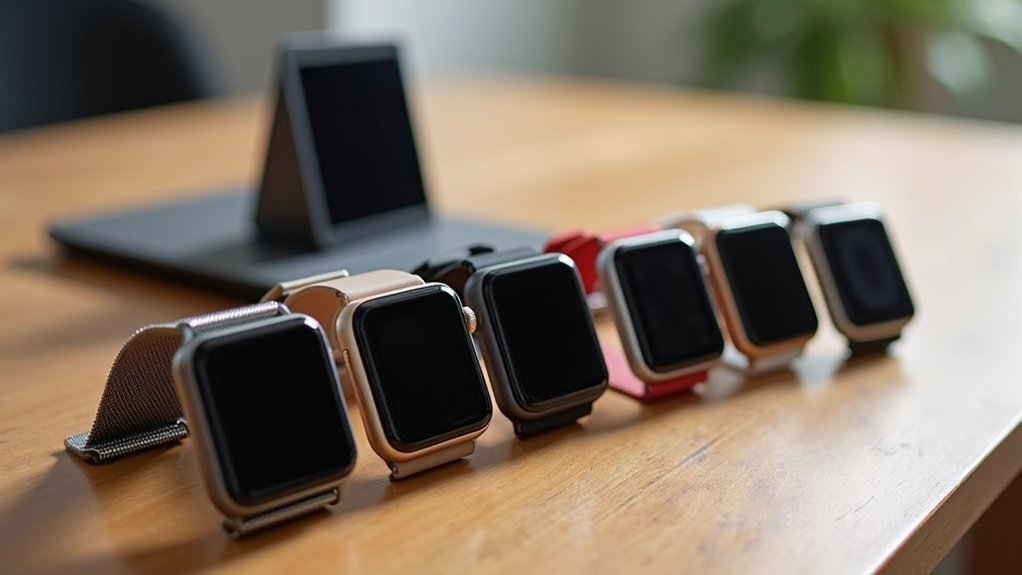
When it comes to smartwatch endurance, display technology largely determines how long your device will last between charges. MIP displays lead the pack, with models like the Garmin Instinct 2X Solar offering an impressive 40 days with solar charging.
For ultimate battery performance, Garmin’s Enduro 3 dominates with up to 36 days standard use and a staggering 90 days with solar exposure. COROS APEX 2 Pro delivers 24 days of regular use without solar assistance.
In contrast, mainstream watches offer considerably shorter battery life: Apple Watch Series 10 lasts about 18 hours, while Samsung Galaxy Watch 7 provides around 24 hours.
Even with power-saving modes, Apple Watch Ultra 2 maxes out at 76 hours, severely limiting smart features.
While power-saving modes extend the Apple Watch Ultra 2 to 76 hours, you’ll sacrifice most advanced functionality in the process.
GPS usage dramatically reduces battery life, especially dual-band GPS which enhances location precision but consumes more power. The OnePlus Watch 2 stands out among Wear OS devices with its hybrid interface system that intelligently manages power consumption for extended battery life.
Ranking the Ultra-Long Battery Champions (30+ Days)
While most mainstream smartwatches require daily charging, a select group of ultra-long battery champions can keep ticking for weeks or even months between charges. The Garmin Enduro 3 leads with an impressive 36-day battery life, extendable to 90 days with solar charging. The Instinct 2X Solar offers potentially unlimited battery with ideal sun exposure, making it perfect for outdoor enthusiasts. The Withings ScanWatch 2 provides up to 30 days of battery life while maintaining a slim and lightweight profile for comfortable extended wear.
| Model | Standard Battery | Solar/Power Saving |
|---|---|---|
| Garmin Enduro 3 | 36 days | 90 days (solar) |
| Garmin Instinct 2X | 40 days | Unlimited (solar) |
| TicWatch Pro 5 | 90 hours | 45 days (power save) |
For those seeking exceptional longevity without compromising features, these ultra-marathon devices deliver performance that outpaces conventional smartwatches by weeks, freeing you from the charging cable’s tether.
Mid-Range Battery Performers (10-30 Days)
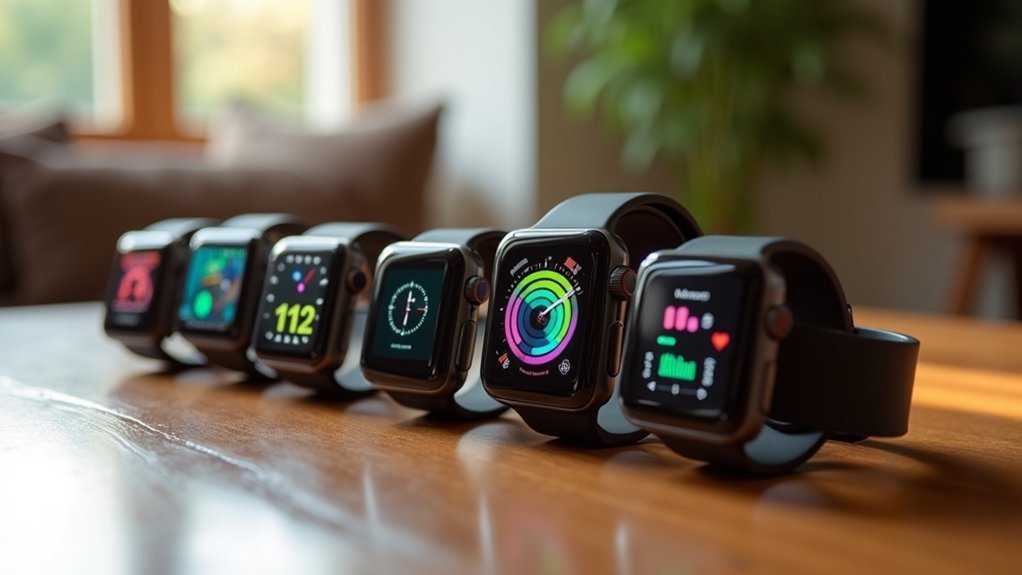
Between daily chargers and month-long marathoners lies a sweet spot of mid-range battery performers delivering impressive 10-30 day lifespans.
The Suunto Race leads this category with 16 days of power, while Garmin Venu 3 and Xiaomi Smart Band 8 Pro both offer 14-day endurance. The Amazfit Balance also delivers impressive battery life, lasting up to 14 days between charges. The Polar Vantage V3 rounds out this group with a respectable 10-day battery life.
These devices balance longevity with robust feature sets, including extensive health tracking, activity monitoring, and smartphone notifications.
The Garmin and Suunto models excel in durability for outdoor enthusiasts, while Polar offers detailed workout analysis.
Though they don’t match the smart capabilities of premium WearOS watches, their battery efficiency means you’ll spend more time wearing them and less time charging—perfect for active users who prioritize functionality over constant recharging.
Daily Charging vs. Weekly Charging Models
When choosing between daily or weekly charging smartwatches, you’ll face clear tradeoffs between device capabilities and convenience.
Daily chargers like the Apple Watch Ultra 2 (46 hours) and Galaxy Watch 6 Classic (35 hours) offer advanced features but require consistent charging routines, while weekly options like Garmin’s fenix 8 (29 days) and Instinct 2X Solar (up to 40 days) provide freedom from frequent plugging in.
Your usage patterns—whether you prioritize always-on displays and constant connectivity or prefer extended battery life with more limited smart functions—will ultimately determine which charging model best fits your lifestyle. Battery experts recommend maintaining charges between 20% and 80% for optimal long-term battery performance.
Daily Charging vs. Weekly Charging Models
Smartwatch consumers today face a clear choice between models requiring daily power replenishment and those lasting a week or longer on a single charge. Your lifestyle and priorities should guide this decision, as each approach offers distinct advantages.
Daily charging smartwatches typically feature:
- Rich AMOLED displays with vibrant visuals and extensive functionality
- Extensive health tracking and smart features like GPS and notifications
- More compact, lightweight designs due to smaller batteries
- Premium options like Apple Watch and Samsung Galaxy series
The OnePlus Watch 2 offers an impressive 100 hours of battery life in everyday mode, positioning it between daily and weekly charging requirements.
Weekly charging models prioritize endurance with MIP displays, solar charging capabilities, and streamlined feature sets.
These watches cater to outdoor enthusiasts and those who find daily charging disruptive to continuous health monitoring, especially sleep tracking. Models like Garmin Enduro 3 and COROS VERTIX 2S exemplify this approach.
Usage Pattern Impacts
While battery ratings provide baseline expectations, your unique usage patterns ultimately determine how frequently you’ll need to charge your smartwatch. GPS activities greatly reduce runtime—Garmin’s fenix 8 Solar offers up to 149 hours, while the COROS APEX 2 Pro delivers 24 hours with dual-band GPS.
Your health monitoring choices matter too. Sleep tracking, continuous ECG, and always-on displays can considerably impact battery life. The Withings Nova stands out by offering battery life of weeks, not days, with charging reminders arriving only every 3-4 weeks.
Solar-equipped models like the Enduro 3 extend runtime from 36 to 90 days with adequate sun exposure, even functioning “indefinitely” in ideal conditions.
Consider how you’ll use your watch: Athletes tackling ultramarathons might prefer the COROS Vertix 2S’s 40-day battery, while frequent travelers benefit from the Enduro 3’s minimal charging needs.
Even power-hungry models like Apple Watch Ultra 2 can reach 76 hours in power-saving mode.
Feature Trade-offs Matrix
Understanding battery life expectations means examining the core trade-offs between daily and weekly charging smartwatches. Your choice ultimately reflects your priorities between convenience and capabilities.
- Daily Chargers (Apple, Samsung): Offer rich ecosystems, vibrant AMOLED displays, and extensive smart features but require nightly charging routines.
- Weekly Chargers (Garmin, COROS): Provide extended independence from charging (30-40 days) but often sacrifice display quality or certain connectivity features.
- Premium vs. Basic: Higher-priced models like the Garmin Enduro 3 ($900+) deliver exceptional battery life while budget options typically require more frequent charging.
- Feature Sacrifice: Gaining extended battery often means foregoing speakers, microphones, or touchscreen responsiveness that daily chargers prioritize.
GPS Mode Battery Life Showdown
You’ll find remarkable differences when comparing ultra-long tracking capabilities, with the Garmin Enduro 3 leading at 120 hours of GPS tracking that extends to a staggering 320 hours with solar charging.
Navigation features greatly impact battery performance, with dual-band GPS offering superior accuracy at the cost of faster battery drain. The Garmin Fenix 8 Solar also leverages solar charging capabilities to significantly extend its operational time.
Your choice between models like the COROS VERTIX 2S (118 hours) and Polar Pacer Pro (35 hours) should depend on whether you need week-long expedition tracking or just weekend adventure support.
Ultra-Long Trackers Compared
Five leading ultra-long battery life trackers dominate the market when you need exceptional GPS performance without constant recharging. The Garmin Enduro 3 leads with up to 90 days of smartwatch mode when solar-charged, while COROS VERTIX 2S delivers 40 days regular use and an impressive 118 hours of GPS tracking. The Polar Grit X2 Pro offers remarkable flexibility with 140 hours in Eco Training mode.
- Solar Advantage: Models like the Garmin Instinct 2X Solar offer “unlimited” battery life with adequate sun exposure.
- GPS Endurance: COROS VERTIX 2S (118 hours) and Garmin fenix 8 51mm Solar (95 hours) excel in GPS longevity.
- Display Technology: MIP displays consistently outperform AMOLED options for battery conservation.
- Quick Charging: Suunto Race goes from empty to full in under an hour, minimizing downtime.
For extreme adventures or simply reducing charging frequency, these ultra-long trackers deliver unmatched performance.
Navigation Battery Drain
GPS mode represents the ultimate battery test for smartwatches, with dramatic differences emerging between models when navigation features are activated.
The Garmin Enduro 3 dominates with an impressive 120 hours of standard GPS tracking, extending to a remarkable 320 hours with solar charging.
For extreme adventures, you’ll find the COROS VERTIX 2S offers 118 hours in standard GPS mode, while Garmin’s Instinct 2X Solar and fenix 8 Solar deliver 145 and 149 hours respectively with solar supplementation.
If you’re using dual-band GPS for improved accuracy, expect significant battery reductions—the Enduro 3 drops to 60 hours, while the VERTIX 2S and Polar Grit X2 Pro both manage 43 hours. Users should note that activity tracking during outdoor sports like skiing will substantially decrease these battery estimates.
For multi-day expeditions, consider disabling heart rate monitoring to extend runtime.
Power Saving Mode Effectiveness Compared
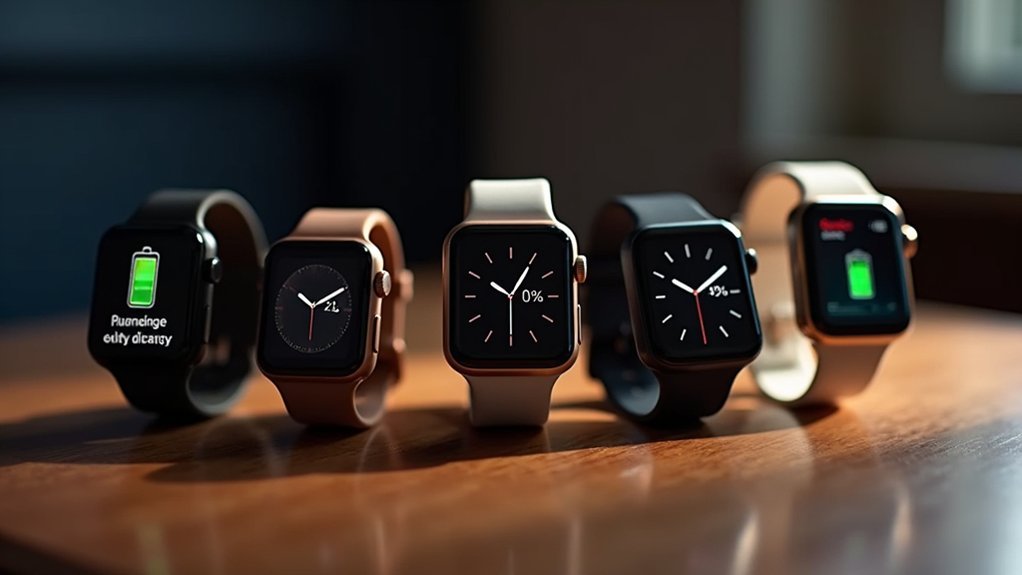
When comparing power saving modes across smartwatch brands, clear differences emerge in their effectiveness at extending battery life. The OnePlus Watch 2 stands out with its impressive 12-day battery life in power-saver mode, outperforming many competitors including the Samsung Galaxy Watch 6 Classic.
Modern power-saving advancements reveal OnePlus Watch 2’s dominance, offering nearly two weeks of use when competitors fall short.
- OnePlus Watch 2 leads with up to 12 days in power-saver mode, combining efficient hardware with optimized software.
- Apple Watch Ultra achieves up to 60 hours during GPS activities with low power mode enabled.
- Garmin devices can extend battery life by up to 12 days with specialized low-power watch faces.
- Wear OS watches typically focus on reducing screen brightness and limiting connectivity features.
These power-saving capabilities vary considerably between brands, with each implementing different strategies to balance functionality with extended battery performance. Disabling unnecessary connectivity features when activating power-saving modes can significantly improve battery longevity across all smartwatch models.
Solar Charging Technology Impact on Battery Longevity
Solar charging technology represents one of the most notable advancements in smartwatch battery longevity, with certain models achieving up to 70 days of continuous operation under ideal conditions.
Garmin’s Instinct Crossover Solar exemplifies this revolution, delivering a 150% battery boost compared to its non-solar counterpart.
For peak performance, you’ll need approximately three hours of direct sunlight (50,000 lux) daily. Real-world benefits vary greatly based on your location and activities—overcast days provide minimal charging at just 1,000 lux.
While solar technology extends GPS runtime by 1-10+ hours, continuous heart rate monitoring and tracking will still accelerate battery drain. Models like the Fenix 6X Pro Solar demonstrate how transflective MIP displays contribute to energy efficiency while enhancing sunlight readability.
The technology comes with trade-offs: solar-enabled watches typically feature monochrome displays rather than power-hungry AMOLED screens, prioritizing longevity over visual appeal.
Battery Size vs. Performance Correlation
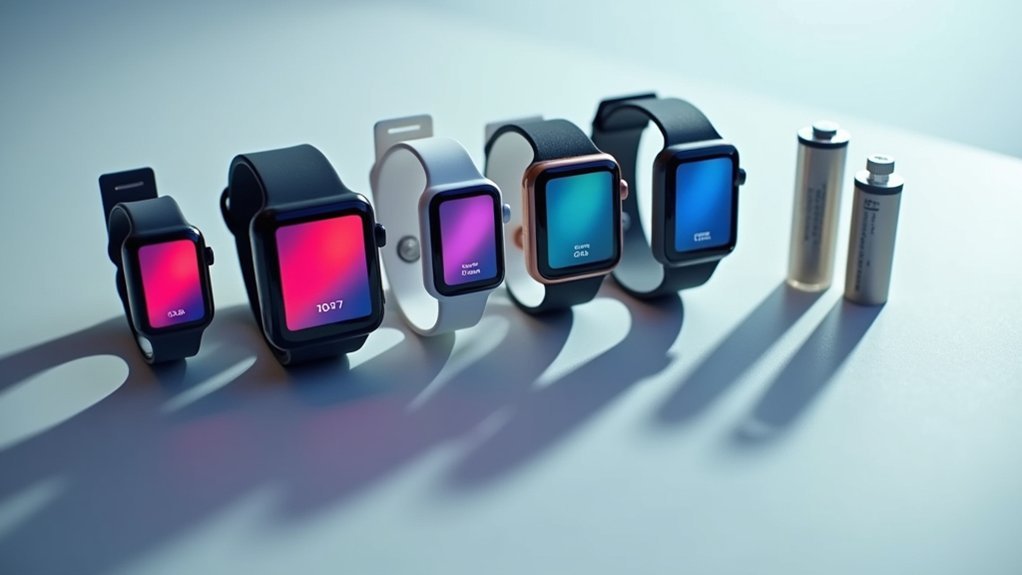
Despite their growing list of advanced features, smartwatches face a fundamental physical constraint that drives every aspect of their design and performance: battery size.
The correlation between battery capacity and performance is surprisingly complex. Most smartwatches contain batteries ranging from 300-500 mAh, yet their runtime varies dramatically. This relationship depends on several critical factors:
- Display technology: AMOLED screens consume markedly less power than LCD alternatives, especially with dark interfaces.
- Processing efficiency: How optimized the operating system is matters more than raw battery size.
- Feature utilization: GPS and heart rate monitoring can reduce battery life by 60-70% when active.
- Battery materials: New high-density materials can pack more power into the same physical footprint.
With wearable devices requiring 50-100 charge cycles annually without significant degradation, manufacturers are prioritizing battery longevity in their development processes.
Understanding this correlation helps you select a smartwatch that balances your specific feature needs with acceptable battery life.
Best Battery Life for Fitness and Outdoor Activities
Fitness enthusiasts and outdoor adventurers require smartwatches that won’t die during crucial moments on trails or in competitions.
Nothing disrupts an outdoor adventure like a dead smartwatch when you need it most.
For extended adventures, the Garmin Enduro 3 stands out with up to 90 days of battery life with solar charging and impressive 120 hours of GPS tracking.
If you’re tackling multi-day hikes, consider the COROS VERTIX 2S with its 40-day battery life or the Garmin Instinct 2X Solar that offers potentially unlimited power with sufficient sunlight exposure.
Runners will appreciate the COROS APEX 2 Pro’s 24-day battery life or the feature-rich Garmin Forerunner 955 Solar.
Solar-charging models like the Garmin fenix 8 series provide the best combination of advanced tracking features and longevity, ensuring you’ll stay connected throughout your outdoor pursuits without constant recharging. The Fenix 8 AMOLED Sapphire specifically delivers up to 29 days in Smartwatch Mode and an impressive 84 hours in GPS Mode, making it ideal for extended expeditions.
How Display Technology Affects Battery Duration
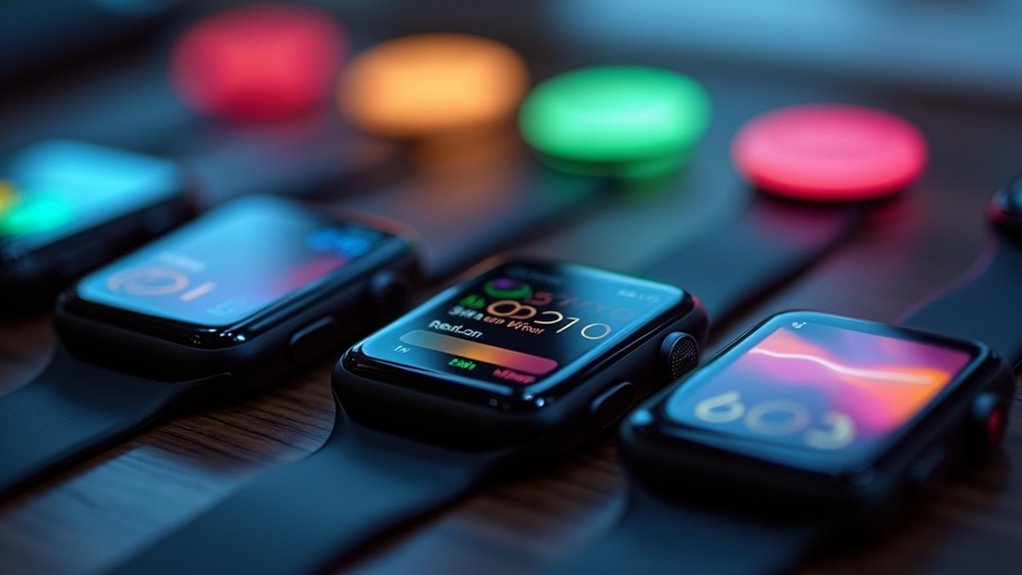
Display technology is one of the biggest factors determining your smartwatch’s battery life, with AMOLED screens offering vibrant colors but consuming more power than MIP (Memory-In-Pixel) displays that excel in outdoor visibility and energy efficiency.
When you enable the Always-On Display feature, you’ll typically see your battery life decrease by 30-50% compared to having it turned off. Battery performance relies on the continuous movement of ions between the anode and cathode during operation.
You can greatly extend your smartwatch’s runtime by adjusting brightness levels, choosing simpler watch faces, and toggling AOD based on your daily needs.
AMOLED Vs MIP Benefits
When choosing a smartwatch, the display technology greatly impacts your battery life experience. MIP (Memory-In-Pixel) displays use reflective technology that relies on external light, making them more energy-efficient than AMOLED screens, which require power to illuminate each pixel.
- Battery Performance: MIP displays typically offer considerably longer battery life, especially during GPS activities and in smartwatch mode. However, overall watch technology is more important, as some AMOLED watches like the Forerunner 965 can outlast MIP models despite having more power-hungry displays.
- Visibility Differences: MIP excels in bright sunlight due to its reflective nature, while AMOLED provides superior contrast and viewing angles in other conditions.
- Color Range: AMOLED delivers richer visuals with up to 64,000 colors versus MIP’s limited 64 colors.
- Longevity Factors: MIP displays maintain quality over time with minimal degradation, while AMOLED screens face potential burn-in issues.
Always-On Display Impact
Battery consumption skyrockets when you enable the always-on display feature in smartwatches, creating a considerable trade-off between convenience and power efficiency.
On Apple Watches, this feature drains 1-2% battery per hour, while smartphones can lose up to 20% daily with always-on activated.
Your display technology matters tremendously. AMOLED screens offer better efficiency for static content, but still consume substantial power when always showing information. Testing shows devices with always-on displays drain battery approximately 4 times faster than when this feature is disabled.
To maximize battery life, you’ll want to choose simpler watch faces, reduce brightness settings, and consider scheduling when the always-on display activates.
Many manufacturers now provide customization options specifically designed to minimize battery impact.
Charging Speed and Recovery Time Analysis
Unlike previous generations of wearables that required lengthy charging sessions, today’s smartwatches have dramatically improved their power recovery capabilities.
Apple leads the pack with its Series 10 reaching 80% in just 30 minutes, while competitors like the Pixel Watch 3 and Galaxy Watch 6 Classic require 78-79 and 82 minutes respectively for a full charge. In real-world testing, the Apple Watch Series 10 reached 64% at 30 minutes.
- Apple Watch Series 10 dominates with the fastest charging (full charge in 60 minutes)
- Quick 15-minute charges provide 20-22% battery boost on Galaxy and Pixel watches
- Larger batteries in devices like Apple Watch Ultra 2 (~564 mAh) naturally require longer charging times
- Partial charges between 20-80% are recommended for ideal battery health and longevity
Real-World Battery Performance vs. Manufacturer Claims
While charging speed offers valuable insights into smartwatch usability, the gap between advertised battery life and real-world performance tells the more complete story.
You’ll find manufacturer claims often reflect ideal lab conditions rather than everyday usage patterns.
When you activate features like continuous heart rate monitoring, GPS tracking, and notifications, battery life typically plummets. For instance, the Apple Watch Ultra 2 delivers about 46 hours versus claimed 36 hours, but enabling power-saving mode severely limits functionality.
Similarly, the Samsung Galaxy Watch 6 Classic averages 35 hours of actual use. The Garmin Venu 3 stands out with superior battery life of 143 hours without GPS activation.
The discrepancy exists across brands, with Garmin Vivosmart 5 lasting only three days compared to its advertised seven, and Huawei Watch GT 3’s 14-day claim rarely materializing with full feature activation.
Frequently Asked Questions
How Does Temperature Affect Smartwatch Battery Performance?
Temperature considerably impacts your smartwatch battery. Heat temporarily boosts performance by 20% but reduces lifespan over time. Cold decreases efficiency. You’ll get better battery health by charging in cool, well-ventilated areas and avoiding extreme temperatures.
Can Battery Health Be Monitored on Smartwatches?
Yes, you can monitor battery health on your smartwatch through periodic or live monitoring features. Most smartwatches provide battery level updates via Bluetooth and offer specific apps to track and manage battery performance effectively.
Are Replacement Batteries Available for Popular Smartwatch Models?
Yes, you’ll find replacement batteries for popular smartwatches from Samsung, Garmin, Fitbit, and other brands. They’re designed to meet OEM specifications with appropriate voltage and capacity for your specific model.
How Do Third-Party Apps Impact Battery Life?
Third-party apps drain your battery considerably faster—up to 4 times more than built-in apps. They’re less optimized for your device and increase battery consumption through background processes and notifications. Choose only essential apps to conserve power.
What’s the Environmental Impact of Smartwatch Batteries?
Smartwatch batteries damage the environment through lithium extraction, manufacturing emissions, and e-waste. You’re contributing to this cycle when you replace watches frequently. Consider devices with replaceable batteries or those using sustainable materials.
In Summary
When choosing your next smartwatch, you’ll need to balance battery life with features you’ll actually use. Don’t be fooled by manufacturer claims—real-world performance often differs. Consider your lifestyle: multi-week battery might mean fewer smart features, while feature-rich watches typically need more frequent charging. For outdoor enthusiasts, GPS mode runtime should be your priority metric. The perfect battery life is simply the one that fits your daily routine.

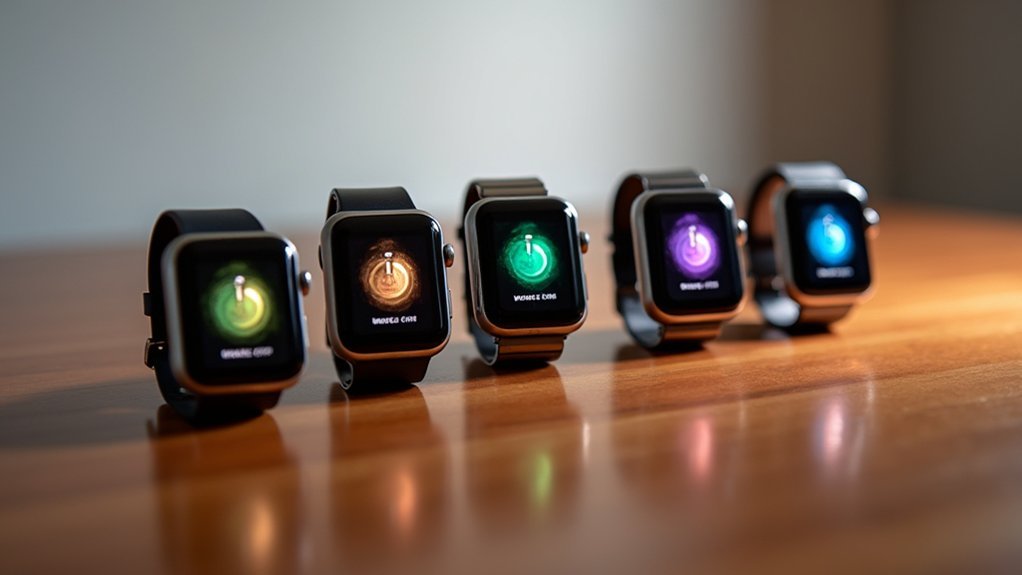

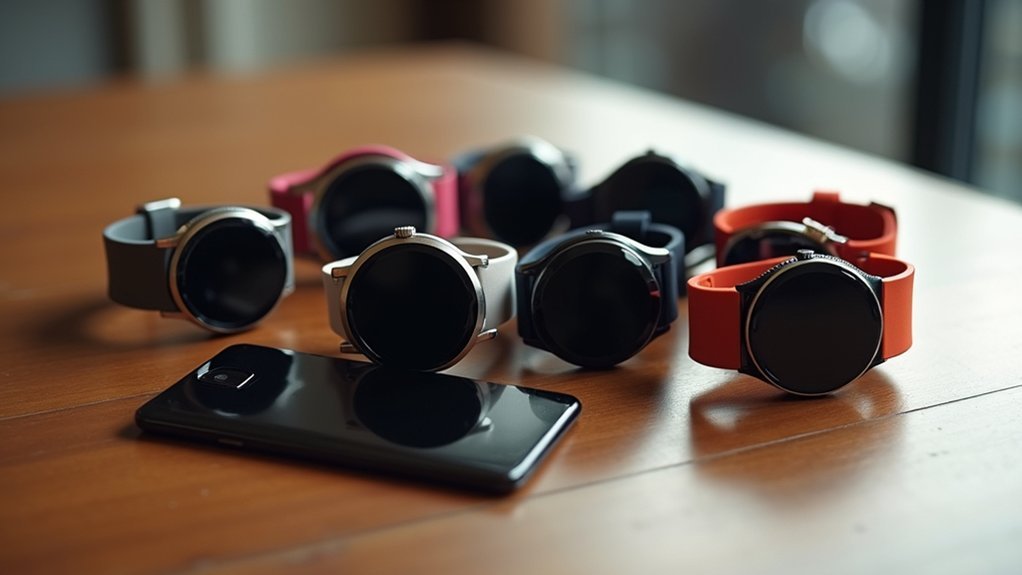
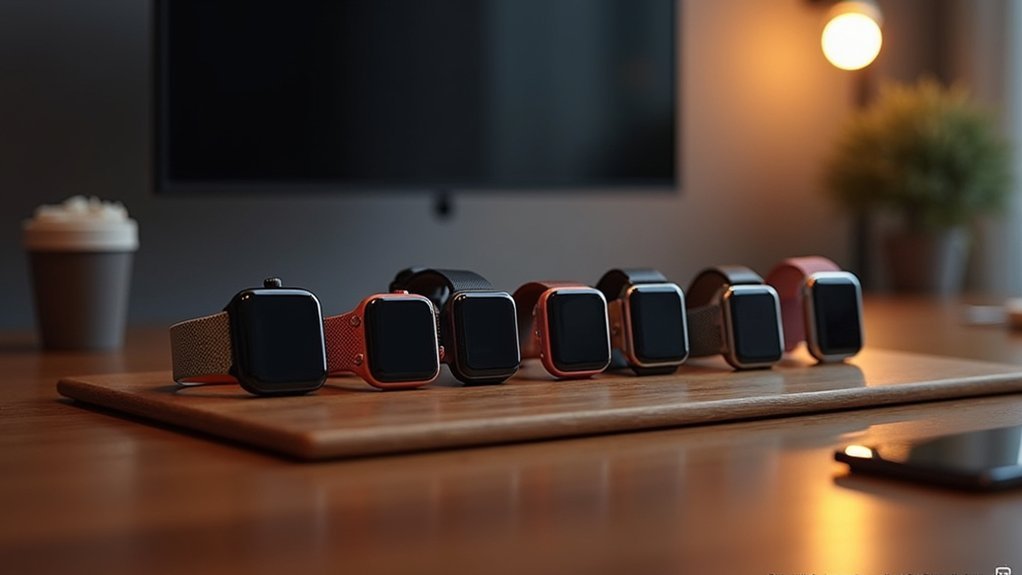
Leave a Reply